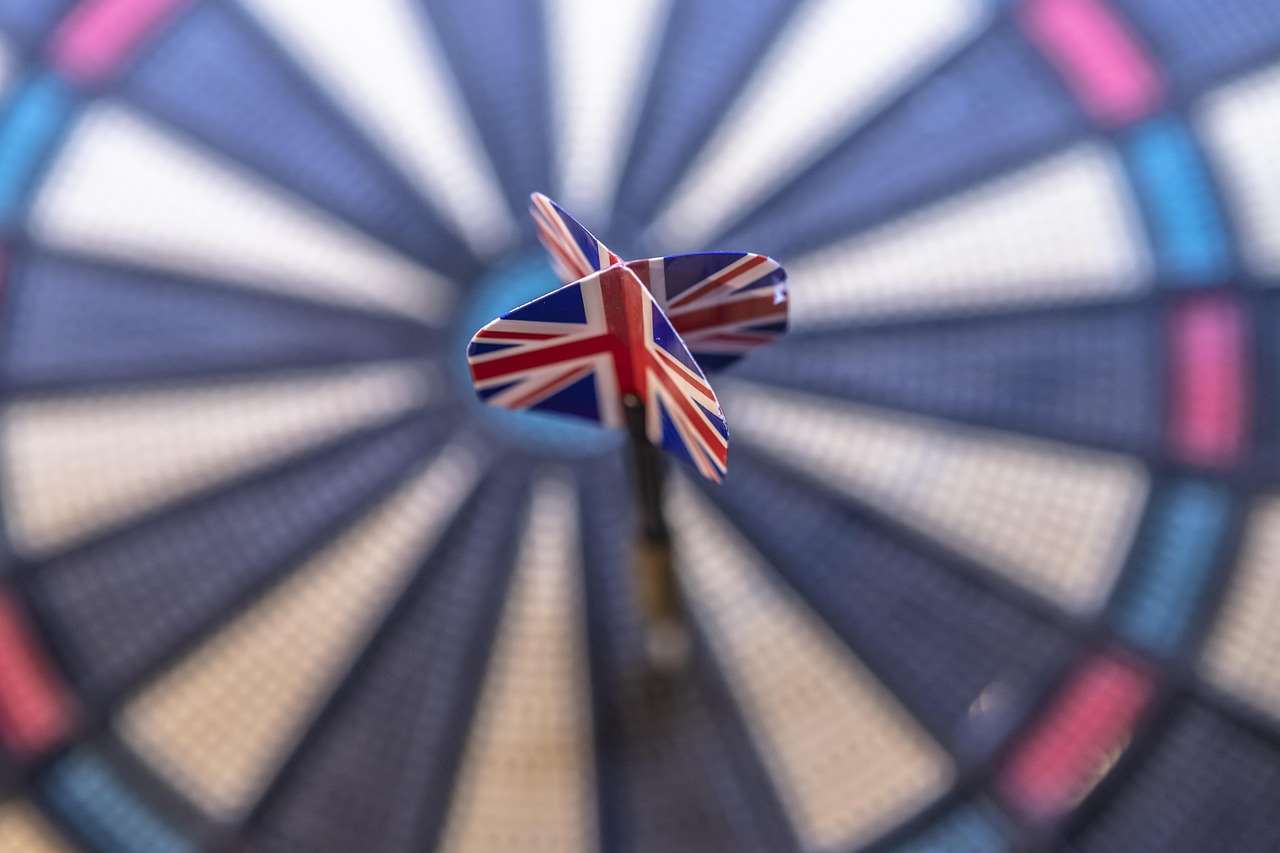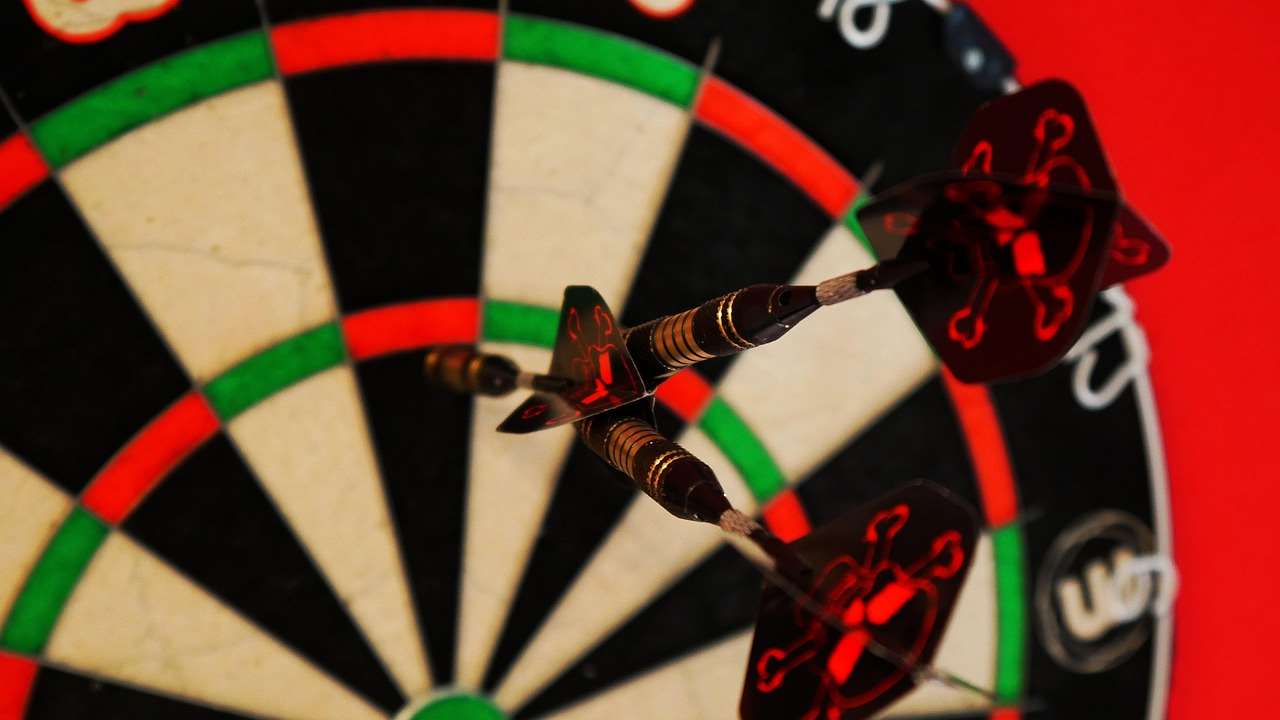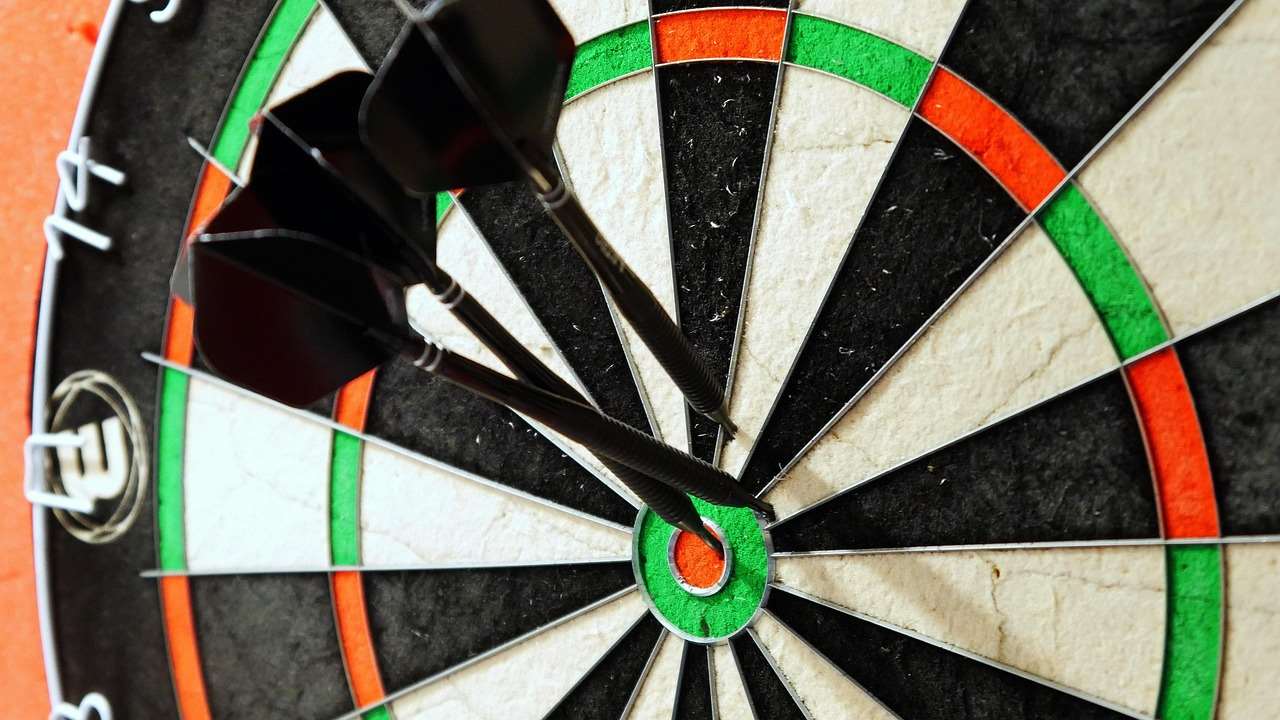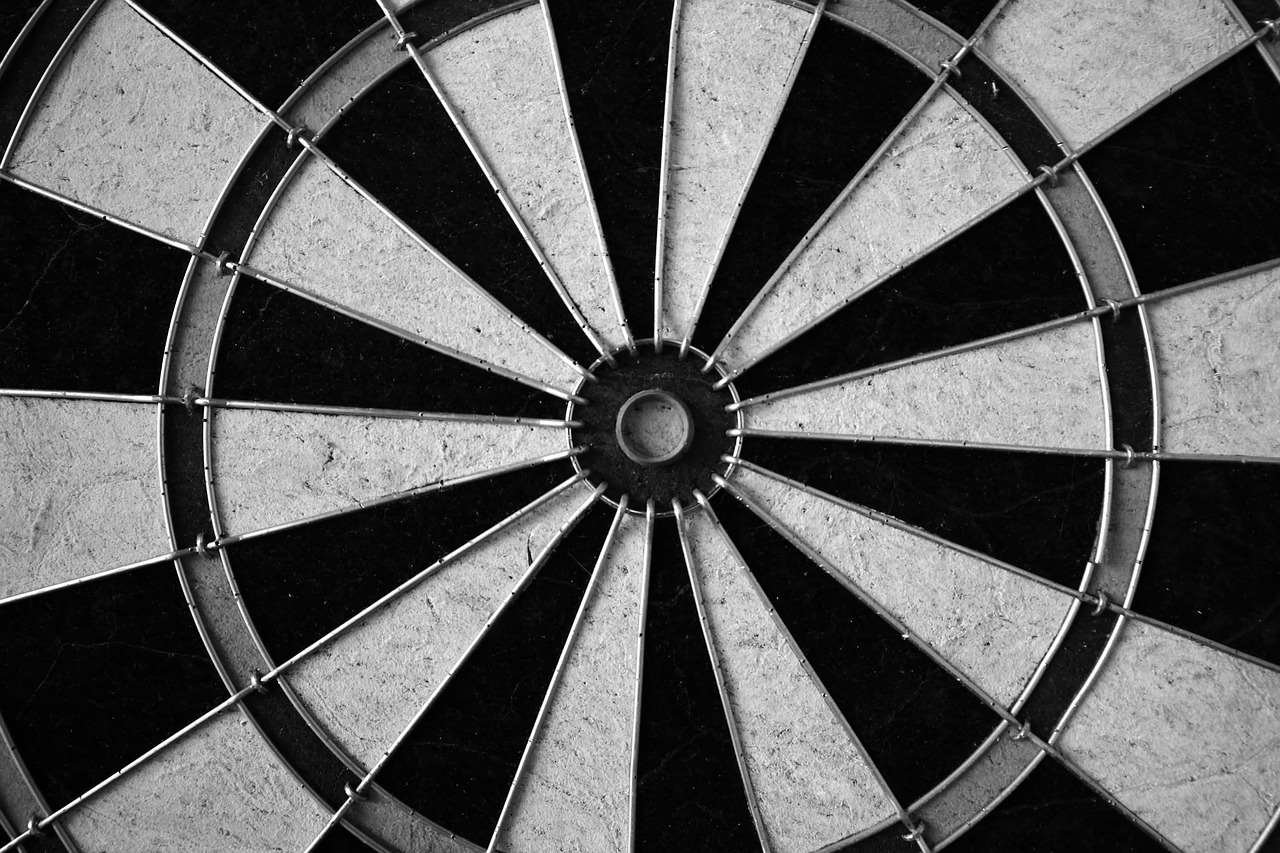Determining **darts who goes first** is usually done by each player throwing one dart at the bullseye; whoever lands closer gets the advantage. This article delves into the nuances of this rule, common variations, and strategies to gain that crucial initial throw advantage, along with insights on fair play and alternative methods for determining the starting player.
⚠️ Still Using Pen & Paper (or a Chalkboard)?! ⚠️
Step into the future! The Dart Counter App handles all the scoring, suggests checkouts, and tracks your stats automatically. It's easier than you think!
Try the Smart Dart Counter App FREE!Ready for an upgrade? Click above!
The Classic Cork-Up: Determining Darts Who Goes First
The most common method to figure out **darts who goes first** is the “cork-up,” also known as “diddling for the middle.” This simple yet effective method involves each player throwing one dart at the bullseye (the “cork”). The player whose dart lands closest to the center of the bullseye wins the right to throw first in the leg or match.

Here’s a breakdown of the classic cork-up:
- The Throw: Each player throws one dart.
- The Target: The bullseye is the target.
- Measuring: The distance from the dart to the center of the bullseye determines the winner. Visual inspection is often sufficient, but disputes may require more precise measurement.
- Re-throws: If a dart falls out before it can be judged, the player gets a re-throw. If both players darts fall out they would both throw again.
Variations and Tiebreakers
While the basic principle is straightforward, the cork-up can present some tricky situations. Here are some common variations and tiebreaker rules:
- Dart in the Bull: If one player hits the bullseye, they automatically win unless the other player also hits the bullseye.
- Two Darts in the Bull: If both players hit the bullseye, the usual rule is to re-throw. Some variations might involve measuring the distance of each dart from the exact center, but a re-throw is more typical.
- Dartboard Obstruction: If a player’s dart lands in the board in a way that obstructs the view of the bullseye for the other player, the obstructing dart should be removed before the second player throws. After the second dart is thrown the first dart is replaced.
- Accidental Throw: If a player accidentally throws their dart before their turn, the dart is scored as zero, and they must wait for their proper turn.
Strategic Diddling: Gaining the Upper Hand
While it might seem like pure luck, there are subtle strategies you can employ to improve your chances of winning the diddle for the middle and therefore determining **darts who goes first**. Consider these points:
- Consistency is Key: Focus on throwing a consistent dart. Don’t try to be too fancy.
- Warm-up: Before the match begins, warm up your throwing arm and practice your aim at the bullseye. A few practice throws can make a significant difference.
- Mental Game: Approach the diddle with confidence. A positive mindset can help you focus and improve your accuracy.
- Dart Condition: Ensure your darts are in good condition. Damaged flights or bent points can affect your throw. Regularly check your dart setup.
Winning the first throw in darts can be a psychological advantage. Knowing that you control the pace of the game can boost your confidence. Also consider using Digital dart score app (https://dartcounterapp.com/) to calculate your points.
Beyond the Cork-Up: Alternative Methods
While the cork-up is the standard, other methods can be used to determine **darts who goes first**, especially in casual settings or if players mutually agree. Here are a few alternatives:
- Coin Toss: A simple coin toss can be used to determine who throws first.
- Rock, Paper, Scissors: Another classic game of chance that can be used to decide the order.
- Highest Score Throw: Each player throws three darts at the board. The player with the highest combined score goes first. This is less common because it involves more throws.
- Agreed Rotation: In casual play, players might simply agree to alternate who goes first in each leg or match.

Fair Play and Etiquette in Darts
Regardless of the method used to determine **darts who goes first**, maintaining fair play and good sportsmanship is crucial. Here are some etiquette guidelines to follow:
- Respect Your Opponent: Show respect for your opponent and their abilities. Avoid trash-talking or unsportsmanlike behavior.
- Avoid Distractions: Refrain from talking or moving while your opponent is throwing.
- Call Your Scores Clearly: Announce your scores clearly and accurately after each throw.
- Acknowledge Good Throws: Congratulate your opponent on good throws, even if they are detrimental to your own game.
- Accept the Outcome: Win or lose, accept the outcome of the game gracefully. Shake hands with your opponent and thank them for the match.
The Importance of the First Throw
In professional darts, the first throw can be a significant advantage. It allows the player to dictate the pace of the game, put pressure on their opponent, and potentially secure an early lead. The **psychological impact of going first** can also be substantial, boosting confidence and potentially unsettling the opponent.
The player going first has the opportunity to score heavily and leave a favorable checkout number. A strong start can put immense pressure on the second player, forcing them to play catch-up. This pressure can lead to mistakes and ultimately increase the chances of the first player winning the leg or match.

Improving Your Darts Game: Practice and Technique
While knowing the rules and etiquette is important, improving your actual darts skills is essential for success. Here are some tips on how to enhance your practice and technique:
- Consistent Stance: Develop a consistent stance and stick with it. This provides a stable base for your throw.
- Grip and Release: Experiment with different grips and release techniques to find what works best for you. A consistent grip is crucial.
- Follow-Through: Focus on your follow-through. A smooth and controlled follow-through helps to ensure accuracy.
- Targeting: Aim for specific targets on the board, not just general areas. Visualize your dart hitting the target before you throw.
- Practice Regularly: Regular practice is key to improving your darts skills. Set aside dedicated time for practice and focus on specific areas of your game.
- Analyse your throws: Review your games and throws, understand where you went wrong.
Advanced Techniques and Strategies
Once you’ve mastered the basics, you can start exploring more advanced techniques and strategies, such as:
- Checkout Combinations: Learn common checkout combinations to improve your scoring efficiency.
- Strategic Scoring: Understand when to aim for high scores and when to play defensively.
- Mental Toughness: Develop mental toughness to handle pressure situations and bounce back from setbacks.
- Reading Your Opponent: Pay attention to your opponent’s body language and throwing patterns to anticipate their moves.

The World of Professional Darts
Professional darts is a thriving sport with a global following. The Professional Darts Corporation (PDC) and the World Darts Federation (WDF) are the two main governing bodies. Tournaments like the PDC World Darts Championship and the wk darts wiki generate huge audiences and offer substantial prize money. Top players like Michael van Gerwen, Peter Wright, and Gerwyn Price are household names.
Watching professional darts can be a great way to learn new techniques and strategies. Pay attention to how the professionals approach the game, their throwing styles, and their mental game. Consider exploring other aspects of darts, such as the darts score program options available for tracking progress. Additionally, understanding nuances like darts double twelve can add depth to your appreciation of the sport. Another player you might find interesting is paul lim darts and his impressive accomplishments.

Equipment: Darts and Dartboards
Choosing the right equipment is essential for optimizing your darts performance. Consider these factors when selecting darts and dartboards:
Darts
- Weight: Darts typically range in weight from 20 to 26 grams. Experiment with different weights to find what feels most comfortable and accurate.
- Material: Darts are usually made of brass, nickel-silver, or tungsten. Tungsten darts are more expensive but offer a slimmer profile and better grip.
- Grip: Choose a dart with a grip that suits your throwing style. Different grips offer varying levels of control and feel.
- Shafts and Flights: Experiment with different shafts and flights to fine-tune the aerodynamics of your darts. Flight shape and shaft length can affect the trajectory and stability of the dart. Also consider the dart shaft diameter when looking at components.
Dartboards
- Material: Dartboards are typically made of sisal fibers. High-quality dartboards offer better durability and self-healing properties.
- Construction: Look for a dartboard with thin wire dividers to minimize bounce-outs. A staple-free bullseye is also desirable.
- Mounting: Ensure the dartboard is mounted securely and at the correct height (bullseye at 5 feet 8 inches from the floor).
Conclusion: Mastering the Throw and the Start
Understanding the process of determining **darts who goes first**, whether through the classic cork-up or an alternative method, is a fundamental aspect of the game. However, mastering the throw, understanding strategy, and practicing consistently are all crucial for achieving success. By focusing on technique, equipment, and mental toughness, you can elevate your darts game to new heights. Take the first step toward improvement: analyze your current game, identify areas for development, and commit to regular practice. Consider joining a local darts league, like those in darts oudenaarde, to enhance your skills, enjoy the social aspect, and refine your strategies.
Ready to take your darts game to the next level? Start practicing your bullseye throws today and experience the thrill of competing in this exciting and strategic sport!
Hi, I’m Dieter, and I created Dartcounter (Dartcounterapp.com). My motivation wasn’t being a darts expert – quite the opposite! When I first started playing, I loved the game but found keeping accurate scores and tracking stats difficult and distracting.
I figured I couldn’t be the only one struggling with this. So, I decided to build a solution: an easy-to-use application that everyone, no matter their experience level, could use to manage scoring effortlessly.
My goal for Dartcounter was simple: let the app handle the numbers – the scoring, the averages, the stats, even checkout suggestions – so players could focus purely on their throw and enjoying the game. It began as a way to solve my own beginner’s problem, and I’m thrilled it has grown into a helpful tool for the wider darts community.